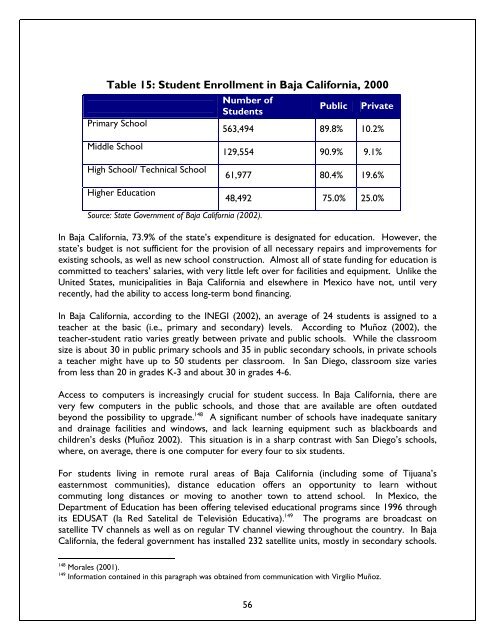Blurred Borders - International Community Foundation
Blurred Borders - International Community Foundation
Blurred Borders - International Community Foundation
Create successful ePaper yourself
Turn your PDF publications into a flip-book with our unique Google optimized e-Paper software.
Table 15: Student Enrollment in Baja California, 2000<br />
Primary School<br />
Middle School<br />
High School/ Technical School<br />
Higher Education<br />
Number of<br />
Students<br />
Source: State Government of Baja California (2002).<br />
56<br />
Public Private<br />
563,494 89.8% 10.2%<br />
129,554 90.9% 9.1%<br />
61,977 80.4% 19.6%<br />
48,492 75.0% 25.0%<br />
In Baja California, 73.9% of the state’s expenditure is designated for education. However, the<br />
state’s budget is not sufficient for the provision of all necessary repairs and improvements for<br />
existing schools, as well as new school construction. Almost all of state funding for education is<br />
committed to teachers’ salaries, with very little left over for facilities and equipment. Unlike the<br />
United States, municipalities in Baja California and elsewhere in Mexico have not, until very<br />
recently, had the ability to access long-term bond financing.<br />
In Baja California, according to the INEGI (2002), an average of 24 students is assigned to a<br />
teacher at the basic (i.e., primary and secondary) levels. According to Muñoz (2002), the<br />
teacher-student ratio varies greatly between private and public schools. While the classroom<br />
size is about 30 in public primary schools and 35 in public secondary schools, in private schools<br />
a teacher might have up to 50 students per classroom. In San Diego, classroom size varies<br />
from less than 20 in grades K-3 and about 30 in grades 4-6.<br />
Access to computers is increasingly crucial for student success. In Baja California, there are<br />
very few computers in the public schools, and those that are available are often outdated<br />
beyond the possibility to upgrade. 148 A significant number of schools have inadequate sanitary<br />
and drainage facilities and windows, and lack learning equipment such as blackboards and<br />
children’s desks (Muñoz 2002). This situation is in a sharp contrast with San Diego’s schools,<br />
where, on average, there is one computer for every four to six students.<br />
For students living in remote rural areas of Baja California (including some of Tijuana’s<br />
easternmost communities), distance education offers an opportunity to learn without<br />
commuting long distances or moving to another town to attend school. In Mexico, the<br />
Department of Education has been offering televised educational programs since 1996 through<br />
its EDUSAT (la Red Satelital de Televisión Educativa). 149 The programs are broadcast on<br />
satellite TV channels as well as on regular TV channel viewing throughout the country. In Baja<br />
California, the federal government has installed 232 satellite units, mostly in secondary schools.<br />
148 Morales (2001).<br />
149 Information contained in this paragraph was obtained from communication with Virgilio Muñoz.















